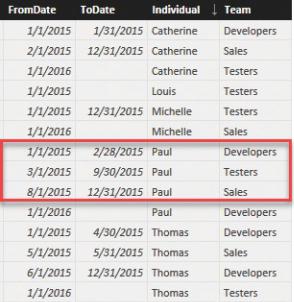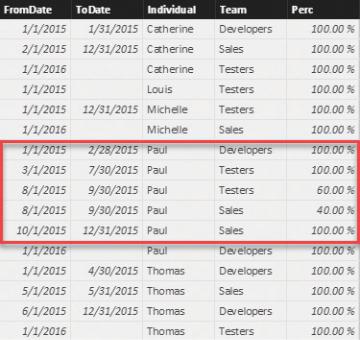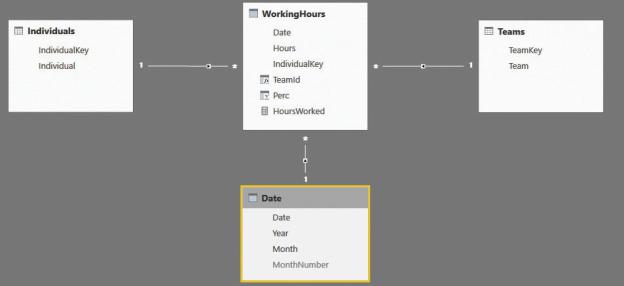
- •Contents at a glance
- •Contents
- •Introduction
- •Who this book is for
- •Assumptions about you
- •Organization of this book
- •Conventions
- •About the companion content
- •Acknowledgments
- •Errata and book support
- •We want to hear from you
- •Stay in touch
- •Chapter 1. Introduction to data modeling
- •Working with a single table
- •Introducing the data model
- •Introducing star schemas
- •Understanding the importance of naming objects
- •Conclusions
- •Chapter 2. Using header/detail tables
- •Introducing header/detail
- •Aggregating values from the header
- •Flattening header/detail
- •Conclusions
- •Chapter 3. Using multiple fact tables
- •Using denormalized fact tables
- •Filtering across dimensions
- •Understanding model ambiguity
- •Using orders and invoices
- •Calculating the total invoiced for the customer
- •Calculating the number of invoices that include the given order of the given customer
- •Calculating the amount of the order, if invoiced
- •Conclusions
- •Chapter 4. Working with date and time
- •Creating a date dimension
- •Understanding automatic time dimensions
- •Automatic time grouping in Excel
- •Automatic time grouping in Power BI Desktop
- •Using multiple date dimensions
- •Handling date and time
- •Time-intelligence calculations
- •Handling fiscal calendars
- •Computing with working days
- •Working days in a single country or region
- •Working with multiple countries or regions
- •Handling special periods of the year
- •Using non-overlapping periods
- •Periods relative to today
- •Using overlapping periods
- •Working with weekly calendars
- •Conclusions
- •Chapter 5. Tracking historical attributes
- •Introducing slowly changing dimensions
- •Using slowly changing dimensions
- •Loading slowly changing dimensions
- •Fixing granularity in the dimension
- •Fixing granularity in the fact table
- •Rapidly changing dimensions
- •Choosing the right modeling technique
- •Conclusions
- •Chapter 6. Using snapshots
- •Using data that you cannot aggregate over time
- •Aggregating snapshots
- •Understanding derived snapshots
- •Understanding the transition matrix
- •Conclusions
- •Chapter 7. Analyzing date and time intervals
- •Introduction to temporal data
- •Aggregating with simple intervals
- •Intervals crossing dates
- •Modeling working shifts and time shifting
- •Analyzing active events
- •Mixing different durations
- •Conclusions
- •Chapter 8. Many-to-many relationships
- •Introducing many-to-many relationships
- •Understanding the bidirectional pattern
- •Understanding non-additivity
- •Cascading many-to-many
- •Temporal many-to-many
- •Reallocating factors and percentages
- •Materializing many-to-many
- •Using the fact tables as a bridge
- •Performance considerations
- •Conclusions
- •Chapter 9. Working with different granularity
- •Introduction to granularity
- •Relationships at different granularity
- •Analyzing budget data
- •Using DAX code to move filters
- •Filtering through relationships
- •Hiding values at the wrong granularity
- •Allocating values at a higher granularity
- •Conclusions
- •Chapter 10. Segmentation data models
- •Computing multiple-column relationships
- •Computing static segmentation
- •Using dynamic segmentation
- •Understanding the power of calculated columns: ABC analysis
- •Conclusions
- •Chapter 11. Working with multiple currencies
- •Understanding different scenarios
- •Multiple source currencies, single reporting currency
- •Single source currency, multiple reporting currencies
- •Multiple source currencies, multiple reporting currencies
- •Conclusions
- •Appendix A. Data modeling 101
- •Tables
- •Data types
- •Relationships
- •Filtering and cross-filtering
- •Different types of models
- •Star schema
- •Snowflake schema
- •Models with bridge tables
- •Measures and additivity
- •Additive measures
- •Non-additive measures
- •Semi-additive measures
- •Index
- •Code Snippets

Reallocating factors and percentages
As the report in Figure 8-15 showed, it looks like Paul accounted for 62 hours in August for both the Sales and the Testers teams. These figures are clearly wrong. Paul cannot have worked for both teams at the same time. In this scenario—that is, when the many-to-many relationship generates overlaps—it is usually a good practice to store in the relationship a correction factor that indicates how much of Paul’s total time is to be allocated to each team. Let us see the data in more detail with the aid of Figure 8-16.
FIGURE 8-16 In August and September 2015, Paul is working for Testers and Sales.
The data in this model does not look correct. To avoid assigning 100 percent of Paul’s time to both teams, you can add a value to the bridge table that represents the percentage of time that needs to be assigned to each team. This requires splitting and storing the periods in multiple rows, as shown in Figure 8-17.

FIGURE 8-17 By duplicating some rows, you can avoid overlaps, and you can add percentages that allocate the hours.
Now Paul’s overlapping periods are divided into non-overlapping periods. In addition, a percentage was added to indicate that 60 percent of the total time should be allocated to the Testers team and 40 percent of the total time should be allocated to the Sales team.
The final step is to take these numbers into account. To do that, it is enough to modify the code of the measure so it uses the percentage in the formula. The final code is as follows:
Click here to view code image
HoursWorked := SUMX (
ADDCOLUMNS ( SUMMARIZE (
IndividualsTeams,
Individuals[IndividualKey],
IndividualsTeams[FromDate],
IndividualsTeams[ToDate],
IndividualsTeams[Perc]
),
"FirstDate", [FromDate],

"LastDate", IF ( ISBLANK ( [ToDate] ), MAX (
), CALCULATE (
SUM ( WorkingHours[Hours] ),
DATESBETWEEN ( 'Date'[Date], [FirstDate], [L VALUES ( 'Date'[Date] )
) * IndividualsTeams[Perc]
)
As you can see, we added the Perc column to SUMMARIZE. We then used it as a multiplier in the final step of the formula to correctly allocate the percentage of hours to the team. Needless to say, this operation made the code even harder than before.
In Figure 8-18, you can see that in August and September, Paul’s hours are correctly split between the two teams he worked with.
FIGURE 8-18 The report shows correctly that Paul was in two teams in August and September, and splits hours between them.
Nevertheless, in doing this operation, we moved to a slightly different data model that transformed the overlapping periods into percentages. We had to do this because we did not want to obtain a non-additive measure. In fact, while it is true that many-to-many relationships are non-additive, it is also true that, in this specific case, we wanted to guarantee additivity because of the data we are representing.
From the conceptual point of view, this important step helps us introduce the next step in the optimization of the model: the materialization of many-to-many relationships.
Materializing many-to-many
As you saw in the previous examples, many-to-many relationships could have

temporal data (or, in general, with a complex filter), percentages, and allocation factors. That tends to generate very complex DAX code. In the DAX world, complex typically means slow. In fact, the previous expressions are fine if you need to handle a small volume of data, but for larger datasets or for heavy environments, they are too slow. The next section covers some performance considerations with many-to-many relationships. In this section, however, we want to show you how you can get rid of many-to-many relationships if you are seeking better performance, and as usual, easier DAX.
As we anticipated, most of the time, you can remove many-to-many relationships from the model by using the fact table to store the relationship between the two dimensions. In fact, in our example, we have two different dimensions: Teams and Individuals. They are linked by a bridge table, which we need to traverse and filter every time we want to slice by team. A more efficient solution would be to store the team key straight in the fact table by materializing the many-to-many relationship in the fact table.
Materializing the many-to-many relationship requires that you denormalize the columns from the bridge table to the fact table, and at the same time increase the number of rows in the fact table. In the case of Paul’s hours that need to be assigned to two different teams during August and September, you will need to duplicate the rows, adding one row for each team. The final model will be a perfect star schema, as shown in Figure 8-19.
FIGURE 8-19 Once you remove the many-to-many relationship, you obtain a normal star schema.
Increasing the row count requires some steps of ETL. This is usually done
